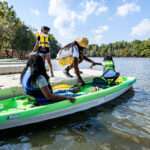Inflatable kayaks are an alternative to hard-shell kayaks that may be more cost-effective and easier for some people to transport. However, they have their own set of safety concerns. In this article, we will discuss the pros and cons of inflatable kayaks as well as ways to ensure your safety when using them.
What are the benefits of an inflatable kayak
- Inflatable kayaks can be a great option for someone who has limited storage space, is short on funds or doesn’t want to carry around the weight of a hard shell. Compared to their counterparts, inflatable kayaks are also very lightweight and come in compact packages that make them easy to transport.
- They’re often less expensive. So that means, you don’t have to burn a hole in your wallet when purchasing one.
- They’re also very durable and sturdy, often made of tough PVC fabric. So they won’t break or leak easily as long as proper care is taken to avoid punctures or tears from sharp objects on the water surface.
- Inflatable kayaks are easy to carry, with handles that allow an individual to transport it without getting tired while carrying a heavy load around their head like you would have to do with hard shell kayaks. As such, this could be a great option for someone who isn’t physically able bodied but still wants to get out on the water by themselves!
Constructions of an Inflatable kayak
Inflatable Kayaks are made from tough PVC fabric. They’re less expensive than hard shell kayaks and come in a variety of shapes, sizes, colors, designs and models. PVC construction makes these Inflatable Kayaks extremely strong and durable. They’re also lightweight, so they’re easy to transport and store when not in use. This means you can easily take it on long hikes but still be able to fold up into a backpack with ease! You’ll never have any trouble transporting or storing your Inflatables for later use again!
The only downside of the PVC construction is that Inflatable Kayaks are not as buoyant as hard shell vessels, but they still offer great protection from debris or rocks on the water’s surface. Not to mention there is no chance of damaging them should you accidentally drop one in shallow water.
If used correctly as there is no possibility of water leaking inside the boat due to punctures or tears from sharp objects on the water surface like some hard shell boats tend to suffer from. – The inflation process takes only about five minutes.
However, you need to check the seams for any leaks before launching. Check the seams carefully for any type of puncture or tear.
Safety Features of An Inflatable Kayak
Maximum Weight limit of the Inflatable Kayak should be checked in advance as not to overload the vessel.
Check for holes or punctures before use to prevent any type of water leakage and subsequent sinking.
Please check if there is a repair kit with your Inflatable Kayak package in advance which you can use it just in case anything goes wrong while on the waters surface, but this should be done every so often as not to forget about its existence during an emergency situation.
If you are looking for inflatable kayaks that have been designed specifically for fishing then we recommend reading our other blog posts where we mention some popular brands such as Sevylor and Intex who offer these types of vessels specially made for fishermen and women alike.
Try to avoid sharp objects while on the water surface and always be cautious of any type of danger or obstacles that could result in a puncture to your inflatable kayak.
Make sure you have inflated the kayak properly. A poorly inflated kayak is a perfect recipe for disaster. A properly inflated kayak is a different story. It will be less difficult to navigate and more stable for fishing purposes, but you still need to keep an eye on it while out on the water surface because things can happen at any moment with no warning signs that might lead up to puncturing your inflatable kayaks bottom or deflating the sides of the vessel by accident.
You need to check for small holes which may have resulted from rocks in shallow waters or sharp objects sticking into the material over time due to rough conditions, as well as paying attention whenever you are paddling near anything dangerous such as a boat harboring motorized vessels. Keep track of how much air pressure has been lost so when it finally reaches its breaking point.
Buoyancy of Inflatable Kayaks
Inflatable kayaks are more buoyant than traditional hardshell vessels of the same size, which makes them safer to use in a wide range of conditions and water depths. This is because they won’t sink or take on much water if punctured by sharp objects such as rocks or sticks when paddling near shallow regions with strong currents.
When using an inflatable kayak you need to be mindful about how deep you go into the waters while fishing for fish, but this can usually be avoided with simple precautions like not attaching hooks directly onto your vessel’s surface area since it reduces the risk of losing tackle during sudden waves caused by motorized boats nearby that might accidentally tear holes in your material.
Last modified: January 2, 2023


